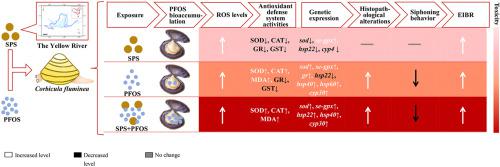Environmental Pollution ( IF 7.6 ) Pub Date : 2020-09-17 , DOI: 10.1016/j.envpol.2020.115671 Yan Liu , Muhammad Junaid , Peng Xu , Wei Zhong , Baozhu Pan , Nan Xu

|
Perfluorooctane sulfonate (PFOS) potentially adsorbs on the surface of suspended sediment (SPS), which can develop a toxic “pool” bioavailable to benthic organisms. In this study, the freshwater clam Corbicula fluminea was employed as a zoobenthos model to study the effects of SPS (collected from the Yellow River) on the bioaccumulation and toxicity (from the molecular level to cellular and physiological levels) caused by PFOS exposure. Besides, the enhanced integrated biomarker response (EIBR) system was applied as an index to evaluate the in-depth toxic effects of PFOS and SPS single and co-exposure at various treatment levels. Our results demonstrated that PFOS-SPS co-exposure (at sub-lethal doses of PFOS) significantly increased the bioaccumulation of PFOS, and induced the elevated levels of reactive oxygen species (ROS), the significantly increased activities of superoxide dismutase (SOD) and catalase (CAT) enzymes, the significantly increased content of malondialdehyde (MDA), and the significantly upregulated expression levels of sod, selenium-dependent glutathione peroxidase (se-gpx), heat shock protein 22 (hsp22), heat shock protein 40 (hsp40) and cytochrome P450 30 (cyp30) genes. Further, the co-exposure induced the significantly higher histopathological alterations in the gonads and digestive glands, and even elevated the inhibition of siphoning behavior in clams. In addition, the EIBR index also revealed the highest values for PFOS and SPS co-exposure, compared to the individual SPS or PFOS exposure. The results indicated that at high levels of PFOS exposure (especially at 1000 μg/L), the presence of SPS might increase the generation of ROS by influencing the bioaccumulation of PFOS, which enhanced the toxicity of PFOS to C. fluminea. These results potentially provide basic information for the comprehensive evaluation of the toxic effects of PFOS on benthos in a multi-sediment river ecosystem.
中文翻译:

悬浮沉淀物通过淡水蛤Cor中的活性氧生成加剧了全氟辛烷磺酸介导的毒性
全氟辛烷磺酸盐(PFOS)可能会吸附在悬浮沉积物(SPS)的表面上,这会形成底栖生物可利用的有毒“池”。在这项研究中,淡水蛤Cor用作底栖动物模型,研究SPS(从黄河收集)对全氟辛烷磺酸暴露引起的生物蓄积和毒性(从分子水平到细胞和生理水平)的影响。此外,增强的综合生物标志物反应(EIBR)系统被用作评估PFOS和SPS单一以及在不同治疗水平下共同暴露的深入毒性作用的指标。我们的结果表明,PFOS-SPS共同暴露(在亚致死剂量的PFOS下)显着增加了PFOS的生物蓄积性,并诱导了活性氧(ROS)的水平升高,超氧化物歧化酶(SOD)和过氧化氢酶(CAT)酶,丙二醛(MDA)含量显着增加,以及MAPK的表达水平显着上调sod,硒依赖性谷胱甘肽过氧化物酶(se-gpx),热休克蛋白22(hsp22),热休克蛋白40(hsp40)和细胞色素P450 30(cyp30)基因。此外,共同暴露在性腺和消化腺中引起明显更高的组织病理学改变,甚至提高了对蛤虹吸行为的抑制作用。此外,与单独的SPS或PFOS暴露相比,EIBR指数还显示了PFOS和SPS共暴露的最高值。结果表明,在高水平的全氟辛烷磺酸暴露量下(尤其是在1000μg/ L时),SPS的存在可能会通过影响全氟辛烷磺酸的生物积累而增加ROS的产生,从而增强了全氟辛烷磺酸对C. fluminea。这些结果可能为全面评估全氟辛烷磺酸对多沉积河流生态系统中底栖生物的毒性作用提供基础信息。











































 京公网安备 11010802027423号
京公网安备 11010802027423号